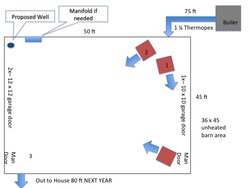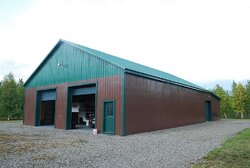From the title you can see I will need heat in the shop ALL winter. Plans are to keep in running until spring (Mid May) then shut down for the summer.
Specs:
Interior Alaska ( can reach -30 to -40 but average is probably 0)
45 x 50 x 14 Shop
300K Sequoyah outdoor wood/coal boiler with 1 1/4 Thermopex for the supply
60-80K wood/coal stove ( only used when I am in the shop)
3x 70K hydronic heaters w/ fans -- two horizontal and one cabinet style
R 40 in walls
R 60 in ceilings
R20 in back wall (connects to unheated space in the barn... this is actually a 50x88)
Heat loss shows 120K -150K needed depending on which calculator
Very Remote so little to no help from plumber/HVAC without considerable expense
Plans are to
1)Heat the shop this year for a place to retreat during the winter and actually be able to do things outside.
2)Put a well in the shop for running water both hot and cold
3) Plumb shop on one zone so when calls for heat all heaters work
4) use 1 1/4 throughout the barn to keep the head down and the btu availability up
5) Minimize pipes as much as possible
6) Also heat hot water as a well is in the future
7) minimize the height of rise to 6 feet to keep the water from boiler one it reaches the negative pressure area. ( expect water line to be 4 feet so a 10 foot rise is a difference of 6 feet approx -2.6 this should give me fluff for a 190 degree water temp boiling based on psi.
8) mount the bottom of the heaters at about the 8 foot mark
Question:
1) Best way to plumb this-- zone valves through manifold or just push water through the heaters and thermostat the fans-- electricity is expensive here so want to balance initial cost with operating cost for a warm shop
2) are the placement of heaters correct
Just need some help on this one. I can do the work but design of plumbing not my strong suit
Thanks -- attached a diagram to help visualize
Specs:
Interior Alaska ( can reach -30 to -40 but average is probably 0)
45 x 50 x 14 Shop
300K Sequoyah outdoor wood/coal boiler with 1 1/4 Thermopex for the supply
60-80K wood/coal stove ( only used when I am in the shop)
3x 70K hydronic heaters w/ fans -- two horizontal and one cabinet style
R 40 in walls
R 60 in ceilings
R20 in back wall (connects to unheated space in the barn... this is actually a 50x88)
Heat loss shows 120K -150K needed depending on which calculator
Very Remote so little to no help from plumber/HVAC without considerable expense
Plans are to
1)Heat the shop this year for a place to retreat during the winter and actually be able to do things outside.
2)Put a well in the shop for running water both hot and cold
3) Plumb shop on one zone so when calls for heat all heaters work
4) use 1 1/4 throughout the barn to keep the head down and the btu availability up
5) Minimize pipes as much as possible
6) Also heat hot water as a well is in the future
7) minimize the height of rise to 6 feet to keep the water from boiler one it reaches the negative pressure area. ( expect water line to be 4 feet so a 10 foot rise is a difference of 6 feet approx -2.6 this should give me fluff for a 190 degree water temp boiling based on psi.
8) mount the bottom of the heaters at about the 8 foot mark
Question:
1) Best way to plumb this-- zone valves through manifold or just push water through the heaters and thermostat the fans-- electricity is expensive here so want to balance initial cost with operating cost for a warm shop
2) are the placement of heaters correct
Just need some help on this one. I can do the work but design of plumbing not my strong suit
Thanks -- attached a diagram to help visualize



